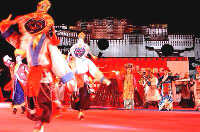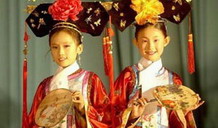Tibetan Opera: 'Living Fossil' of Tibetan Culture
 Tibetan Opera, or Ace Lhamo in Tibetan, is an ancient art form that has developed over the centuries. Hailed as "the living fossil of traditional Tibetan culture," it boasts a history of more than 600 years -- about 400 years longer than China's national treasure, Peking Opera.
Tibetan Opera, or Ace Lhamo in Tibetan, is an ancient art form that has developed over the centuries. Hailed as "the living fossil of traditional Tibetan culture," it boasts a history of more than 600 years -- about 400 years longer than China's national treasure, Peking Opera.
Tibetans have long cherished this important folk art, which has become a source of identity for them. It is said that wherever you find Tibetans, you will find Tibetan Opera.
 Tibetan people's "fairy sisters"
Tibetan people's "fairy sisters"
There is a beautiful legend about Tibetan Opera in its present form. During the 14th century, a high-ranking monk and bridge builder named Drupthok Thangthong Gyalpo decided to build iron bridges across all of the major rivers in Tibet to improve transportation and facilitate pilgrimages.
To fund the project, Thangthong Gyalpo created a singing and dancing group of seven beauties to dance while he played the cymbals and drums. They performed throughout Tibet to earn money for his bridge project. This is believed to be the source of the present Tibetan Opera.
Tibetan Opera became known in the local language as Ace Lhamo ("fairy sisters"), and Thangthong Gyalpo himself is considered as the father of Tibetan Opera.
 To honor the great founding father, a blessing of his statue always precedes each Lhamo and usually ends with the presentation of the hada (a strip of raw silk or linen used for ritual greetings) by the performers and audience members.
To honor the great founding father, a blessing of his statue always precedes each Lhamo and usually ends with the presentation of the hada (a strip of raw silk or linen used for ritual greetings) by the performers and audience members.
 From ritual dances to cultural syncretism
From ritual dances to cultural syncretism
However, some say the origin of Tibetan Opera goes back a millennium to Tibetan ritual dances and early Indian Buddhist drama. Since Buddhist teachings and Tibetan history have provided the inspiration for Tibetan Opera, most of its repertoire is based on Buddhist stories and Tibetan history.
According to Tibetan historical records, when Princess Wencheng of the Tang Dynasty (618-907) was married to the Tibetan King Songtsan Gambo, she brought the costumes, music, and dances of the Han people to Tibet. Such items were greatly admired by the king, who in turn, had 16 beautiful girls trained in an art form combining the Han-style and Tibetan folk music and dance to entertain the princess.
In the eighth century, the Tibetan King Khrisong Detsan became a follower of Buddhism under the influence of his mother, Princess Jincheng of the Tang Dynasty. He invited the Lotus-Born Monk from India to spread Buddhism throughout Tibet and built the Samye Monastery. At the inauguration ceremony, a pantomimic dance show based on the deity worship ritual of the Bon religion (a native religion of Tibet) and Tibetan folk dances were staged.
During the reign of the fifth Dalai Lama in the 17th century, this performing art was separated from religious rituals and became an independent dramatic form. What started off as pantomime evolved into a structured art of song, dance, chants, and narration, accompanied by flamboyant masks. Story lines included the nation's history, ancient legends of heroes and gods, and satires on current events. The tradition was passed down from one generation to the next, developing into Tibetan opera, which was popularized throughout the region.
ancient legends of heroes and gods, and satires on current events. The tradition was passed down from one generation to the next, developing into Tibetan opera, which was popularized throughout the region.
As the opera matured it became increasingly complex in structure, containing many literary strands, with very beautiful story depictions. Over time the opera also absorbed many local dances and other art forms and now, there is always a light-hearted humor in it that appeals to audiences.






